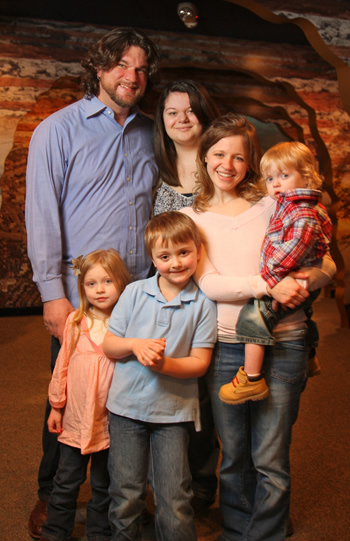Miracle Kids: Gavin Steel
With Cystic Fibrosis and Heart Defect, Seneca Falls Baby Faces Unique Set of Challenges
 Jason and Christie Steel had no reason to suspect they’d need pre-birth genetic screening for their second son. But the set of conditions with which little Gavin was born was so rare that it left many specialists from around the country stumped. Never before had they seen such a unique combination in one baby.
Jason and Christie Steel had no reason to suspect they’d need pre-birth genetic screening for their second son. But the set of conditions with which little Gavin was born was so rare that it left many specialists from around the country stumped. Never before had they seen such a unique combination in one baby.
Doctors initially thought that Gavin had only a heart murmur, but his family soon learned he had been born with a Ventricular Septal Defect (VSD). VSD is the most common type of congenital heart defect in newborns and in many cases, the hole between the two lower chambers of the heart closes up on its own. However, Gavin’s cardiologist was concerned his VSD might cause problems and thought the hole in his heart would need to be closed with surgery. Meanwhile, news came that Gavin’s newborn screening showed that he might have cystic fibrosis. But Gavin needed to gain weight before getting a sweat test, the definitive test for cystic fibrosis.
Jason and Christie closely monitored how much food he was eating and how often he was going to the bathroom.
“We were even weighing diapers at one point,” Christie said.
Despite their efforts, Gavin’s weight went down by six ounces, and after four weeks he was admitted to Golisano Children’s Hospital at the University of Rochester Medical Center. Gavin’s heart failure was controlled with medications and he was evaluated further for possible cystic fibrosis. A stool evaluation showed abnormal digestive enzyme levels consistent with cystic fibrosis. Because Gavin was so small and undernourished, the health care team decided it was best to delay open-heart surgery until he was stronger.
Gavin’s body was fighting itself. The cystic fibrosis, eventually confirmed, was preventing his body from breaking down food enzymes into cellular fat. He was burning up all his energy trying to eat without falling asleep because his heart wasn’t working right, leaving him permanently exhausted.
Gavin was put on a high-calorie diet through a feeding pump to gain the weight he needed for surgery. He underwent open-heart surgery just a few weeks later.
“To perform that kind of surgery on a 2 month old is a reflection of the expertise we have here,” said Clement L. Ren, M.D., an associate professor in Pediatrics at Golisano Children’s Hospital.
Jason and Christie, who’d been staying at the Ronald McDonald House less than a mile away, were given a chance to hold their baby before the surgery — something they hadn’t been able to do for three weeks because Gavin was intubated.
“You don’t want to let him go because you don’t know if you’re holding him for the last time", Jason said. “It was the scariest thing I’ve ever been through in my entire life.”
When Gavin came out of surgery four hours later, his parents were able to catch a glimpse of him — “looking like a little baby doll, all tiny and swollen,” recalled Christie—as he was quickly wheeled to his room. He’d done remarkably well, needing minimal blood transfusions and oxygen.
Unfortunately, there would be more hurdles to overcome. When Gavin stopped breathing in Jason’s arms, he had to be rushed to Golisano Children’s Hospital’s pediatric intensive care unit for intubation, blood transfusions and additional tests. That’s when he was diagnosed with 22q11.2 deletion syndrome, more routinely known as DiGeorge syndrome and caused by the absence of a small piece of chromosome 22. Normally, when the body is fighting off such a serious condition, it tends to shrink while the size of the head remains the same. In Gavin’s case, his head was proportionate to his body, his fingers and toes were elongated, and he had a dual uvula and other characteristics of the syndrome.
 Gavin stayed in the hospital for three months after the emergency visit. Just two days after going home, he wound up back at Golisano Children’s Hospital with a life-threatening respiratory illness known as MRSA pneumonia. After a nearly two-month stay, Gavin had only a week’s reprieve at home before returning yet again for cystic fibrosis-related dehydration, which required another seven days in the hospital. Other hospital visits followed for a strong course of antibiotics and ear tube placements.
Gavin stayed in the hospital for three months after the emergency visit. Just two days after going home, he wound up back at Golisano Children’s Hospital with a life-threatening respiratory illness known as MRSA pneumonia. After a nearly two-month stay, Gavin had only a week’s reprieve at home before returning yet again for cystic fibrosis-related dehydration, which required another seven days in the hospital. Other hospital visits followed for a strong course of antibiotics and ear tube placements.
“We had some really scary moments and felt completely lost, but the communication, coordination and response from everyone at the hospital was great,” said Jason, who has since become a stay-at-home dad to Gavin and his older siblings, Evan, Natalie, and Mercedes. He and Christie, who had both been employees of BonaDent Dental Laboratories in Seneca Falls during Gavin’s ordeal, say the company was tremendously supportive, continually raised money for the family, and allowed time off whenever it was requested. Jason plans to return to work once Gavin starts kindergarten.
Now age 2, Gavin has gained weight and breathes well. Golisano Children’s Hospital is one of the few places in the country that can do lung function testing in infants, and Gavin’s lung functioning, monitored regularly since his cystic fibrosis diagnosis, has improved.
“It took him a long time to catch up, and he’s still not totally there, but he’s probably one of the happiest kids we’ve ever known,” said Christie.
Gavin still has multiple medical needs, though. He takes enzymes every time he eats, is on several inhalers, and has nebulizer and airway clearance vest treatments three times a day (the vest treatment is done up to five times daily when he’s sick). And Golisano Children’s Hospital is still very much a part of Gavin’s life; he was hospitalized for three days recently for severe bronchiolitis.
“We tell everybody that Golisano is the best hospital there is,” said Jason. “We can’t talk highly enough about everybody there. They didn’t just take care of Gavin, they treated the whole family. And they treated us like family.”